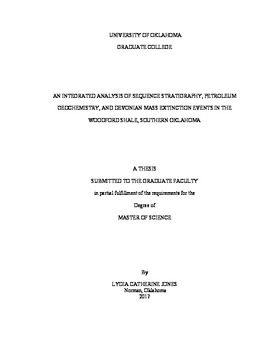| dc.description.abstract | Geochemical analyses of the Late Devonian-Early Mississippian Woodford Shale have revealed a more dynamic history than previously considered, reflecting discrete changes in the conditions surrounding its depositional history. Biomarkers, pyrolysis, and chemostratigraphy provide evidence for paleoenvironmental variations in setting, water chemistry, and organofacies. Dominated by an overall transgressive sequence, the Oklahoma Woodford Shale demonstrates alternating circulation patterns with fluctuating marine and continental organic input, and intermittent events of photic zone euxinia (PZE), resulting in heterogenic distributions regionally and sequentially.
Furthermore, biomarker studies have indicated two Late-Devonian biotic crises including the Frasnian-Famennian (F-F) Kellwasser Event and the Devonian-Carboniferous (D-C) Hangenberg Event. Cumulatively, the two events contribute to one of five of the most devastating mass extinctions in Earth’s history. These boundaries, located in the middle and upper Woodford respectively, have also been closely studied in time-equivalent shales worldwide. Biomarkers from Devonian land plants and their combusted derivatives highlight an influx of continental organic matter into the Late Devonian-Early Mississippian Woodford Sea. Increased soil runoff and nutrient flux from newly evolved vascular plants and massive forest fires could have contributed to the widespread eutrophication and anoxia, which resulted in the high organic matter preservation of this important source rock.
A well-preserved, 80-foot Interstate-35 outcrop in Carter County, Oklahoma provides a unique opportunity to investigate detailed geochemical and stratigraphic trends across the middle and upper Woodford. A biomarker study was conducted to assess complexities of the Woodford’s deposition, with a particular focus on the relationship between sequence stratigraphy, organic input, euxinic episodes, and the two Late Devonian mass extinctions. For the first time, the geochemical evidence of the Hangenberg Crisis is defined for the Woodford Shale. Analysis of biomarkers, including carotenoids, aryl isoprenoids, and polycyclic aromatic hydrocarbons demonstrated cyclic patterns in depositional history, leading to better prediction of hydrocarbon-rich intervals.
This study found aryl isoprenoids and carotenoids, indicators of PZE, to be higher in abundance than previously seen in the upper Woodford, signifying regional differences in circulation and oxic conditions, and possibly greater preservation within the Ardmore Basin. In addition, terrestrially-sourced biomarkers and their pyrogenic derivatives were identified, demonstrating a link between basinal input from land plants and euxinic conditions in the Woodford Sea. | en_US |
